The push-up is one of the best bodyweight exercises for targeting upper-body muscles. Like many other upper-body pressing exercises, push-ups recruit and train the chest, deltoid, and triceps muscle groups.
Push-ups are often thought of as a chest-building exercise, but many variations are great for targeting the shoulders.
Many people are familiar with the standard push-up, but some want to do push-up variations that train the shoulder muscles.
This article describes the best shoulder push-ups and how to do them correctly. It also offers tips and techniques for building bigger, muscular shoulders at home.
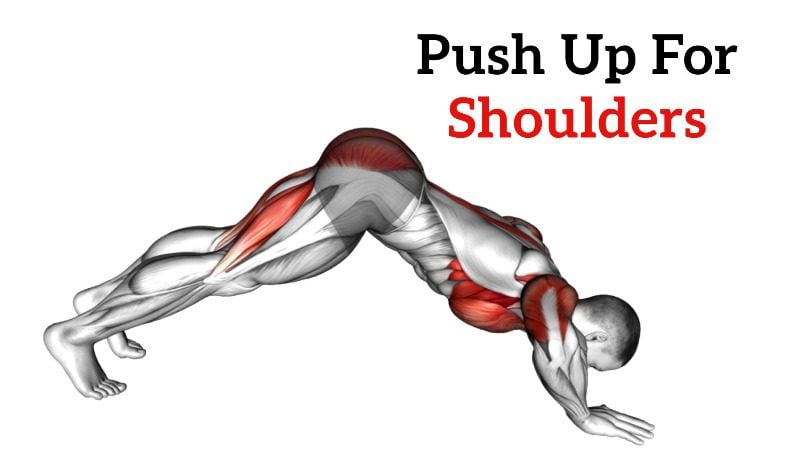
What is Shoulder Push-Ups
Push-ups for shoulders are a great bodyweight exercise for building upper body strength. Despite their name, the benefits of shoulder push-ups extend beyond the shoulders—this exercise helps build muscles in your triceps, glutes, and pecs.
The Shoulder Push-up is a highly effective exercise for general conditioning. It can be performed regardless of where you are, and, best of all, they are entirely free—no expensive gym equipment or no annual gym fees required.
It’s a complete body workout because it tones up the arms, shoulders, and even your lower back. With regular workouts, you can tone your shoulders in no time.
Practicing shoulder push-ups with proper form can improve your shoulder joint health and reduce shoulder pain.
5 Best Push-ups for Shoulder
Let’s explore 5 of the best push-up exercises to help build more muscular, more stable shoulders.
1. Pike Push Up
If you’re looking for a straightforward push-up exercise to add to your shoulder workout routine, pike push-ups are a great staple exercise to get you started.
Pike Push-ups, also known as shoulder push-ups, are a variation of the push-up that increases strength and stability in the shoulders and triceps.
They are a great bodyweight exercise to build the anterior deltoids, triceps, and upper pecs. Performing the exercise more upright will target the deltoid more than the chest.
Pike push-ups are a great transition exercise if you want to build strength for the handstand push-up.
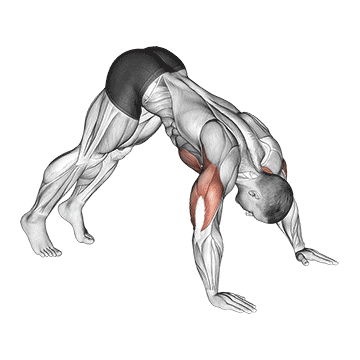
How to do
- Start in a standard push-up position with your hands slightly wider than shoulder-width apart and elbows completely locked out.
- Lift the hips up and back until your body forms an inverted V shape. Keep arms and legs as straight as possible.
- Slowly lower the top of your head towards the ground.
- Once your head is about to make contact with the ground, pause for a second.
- Then slowly push back until your arms are straight, and you’re in the inverted V position.
2. Hindu push up
The Hindu push-up is common in Indian physical culture and martial arts, particularly Pehlwani. Bruce Lee also used it in his training regime.
The Hindu Push-up is a compound bodyweight exercise that simultaneously works on multiple joints and muscle groups.
Hindu push-up is an incredible exercise to develop stronger shoulders, pectoral, arms, core, and spine.
Each repetition involves going from a downward dog position to a cobra pose and swooping by holding the head and body close to the ground.
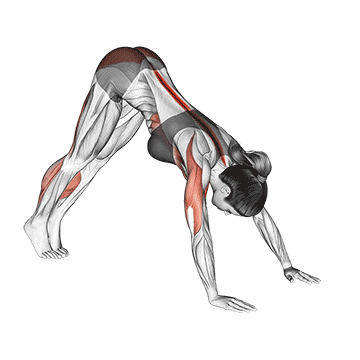
How to do
- Start in a downward dog pose, with your hands shoulder-width apart, your body in a V shape, and your feet hip-width apart.
- Bend your elbows and lower your chest until it’s just above the floor, going into low plank pose.
- In a scooping motion, scoop your head upward while arching your lower and upper back and go into cobra pose.
- To return to the starting position, you do not need to reverse back through the sweeping, arching motion.
- Simply push back into the starting position.
Read More: 25 Different Types Of Push Ups (Best Variations)
3. Decline Push-Up
Decline pushups are a great way to strengthen your chest muscles and train your shoulders and triceps. They are a more challenging version of a regular push-up in which you put your feet higher than your hands.
It’s perfect for intermediate and pros who want to strengthen their upper body.
Decline push-ups primarily work your upper chest and shoulders. They are a great way to build up to the handstand push-up, the best bodyweight shoulder exercise.
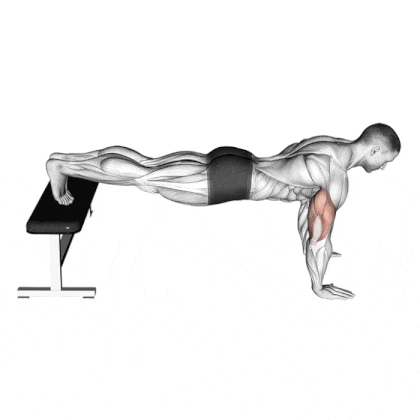
How To Do
- Placed your hands firmly on the floor and spaced slightly wider than shoulder-width apart.
- Put legs on the bench or the pad roller.
- Now, lift yourself off the ground, straightening your elbows and arms. Keep your elbows close to your body.
- Raise until your elbows are almost near to locked, and pause for a moment at the top of the movement.
- Now lower your body slowly and sustainably, feeling the motion all the way down until your chest is very close to the ground.
- Complete 3–4 sets of 8 to 20 repetitions.
Read More: Best Push Ups For Upper Chest To Build Size And Strength
4. Elevated pike push-up
The Elevated Pike Push-Up is an advanced variation of the standard Pike push-up. Your feet are elevated on a bench, box, or any stable surface.
This elevation increases the angle of your body, emphasizing your shoulders, triceps, and upper chest.
When you raise your feet on a box, you advance these holds because you are now stabilizing a heavier percentage of your bodyweight on your arms.
Be sure to have first mastered the pike press before trying the elevated pike press.
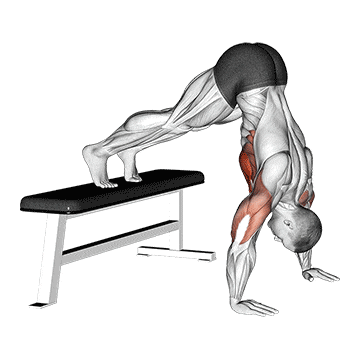
How to do
- Start in a standard push-up position with your hands slightly wider than shoulder-width apart and elbows completely locked out.
- Elevate your feet to an appropriate height for your current strength.
- Lift the hips up and back until your body forms an inverted V shape.
- Keep arms and legs as straight as possible.
- Slowly lower the top of your head towards the ground.
- Once your head is about to contact the ground, pause for a second.
- Then, slowly push back until your arms are straight and you’re in the inverted V position.
5. Handstand Push Up
The handstand push-up, also called the vertical push-up, is one of the best push-up variants for the shoulders, since the body is positioned in a handstand.
Handstand Push-ups show tremendous power and mainly build up the anterior delts, which are the front of your shoulders. It is the king of all shoulder exercises.
In addition to increasing the load on the upper body and strengthening your shoulder stabilization muscles, the one-arm push-ups are just plain cool.
If performed freestanding, handstand push-ups require significant strength, balance, and control. Compared to regular push-ups, they significantly increase the load on the shoulder and triceps brachii muscles.
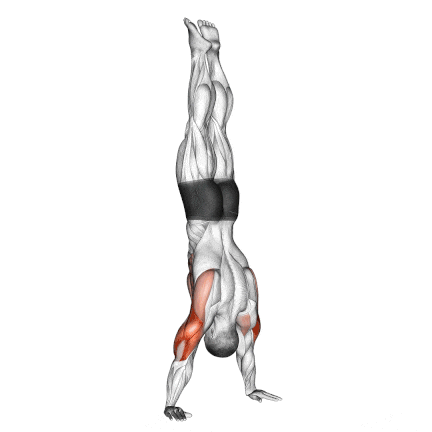
How to do
- Place hands about 6-12 inches away from the wall and slightly wider than shoulder width apart.
- Make sure palms are facing forward, or slightly turned out 5-10 degrees.
- Kick up into a handstand with your heels touching the wall.
- Once you have kicked up, establish a strong, rigid midline position.
- While maintaining this position, lower yourself until the top of your head touches the floor/mat.
- Try to keep your elbows at a 45-degree angle as you lower.
- Once your head touches the floor, press up with the same tightness you used to lower yourself until your elbows reach full extension.
Why Shoulder Push-Ups Are Important
When combined with a solid exercise routine, shoulder push-ups are a perfect way to build strength and balance throughout your body. Let’s take a look at why this is so beneficial for you.
- Shoulder push-ups are an effective exercise routine for strengthening and toning your shoulders, chest, tricep, upper back and core.
- They are also a great way to improve your posture and help prevent the onset of slouched shoulders.
- Push-ups challenge your strength and coordination to a whole new level. They not only build strength but also work on endurance and stamina.
- Push-ups for the shoulder also strengthen the trapezoid and rear deltoid muscles, the two most important shoulder muscles.
- Fortunately, shoulder push-ups at home do not require much effort. All you need are some chairs or a table and the ability to hold yourself with your toes off the floor.
- By doing this routine regularly, you will see results in as little as two weeks of practice.
- If you can’t perform all these exercises now, don’t worry! Read on to discover how to progress gradually towards them.
Reference
- Kim YS, Kim DY, Ha MS. Effect of the push-up exercise at different palmar width on muscle activities. J Phys Ther Sci. 2016 Jan;28(2):446-9. doi: 10.1589/jpts.28.446. Epub 2016 Feb 29. PMID: 27064571; PMCID: PMC4792988.
- Dhahbi W, Chaabene H, Chaouachi A, Padulo J, G Behm D, Cochrane J, Burnett A, Chamari K. Kinetic analysis of push-up exercises: a systematic review with practical recommendations. Sports Biomech. 2022 Jan;21(1):1-40. doi: 10.1080/14763141.2018.1512149. Epub 2018 Oct 4. PMID: 30284496.
- Kim, You-Sin & Lee, Namju & Jung, Seung. (2018). Electromyographic comparison of modified push-up exercise: focused on various arm position. 36-42. 10.12925/jkocs.2018.35.1.36.

Manish is a NASM-certified fitness and nutrition coach with over 10 years of experience in weight lifting and fat loss fitness coaching. He specializes in gym-based training and has a lot of knowledge about exercise, lifting technique, biomechanics, and more.
Through “Fit Life Regime,” he generously shares the insights he’s gained over a decade in the field. His goal is to equip others with the knowledge to start their own fitness journey.
